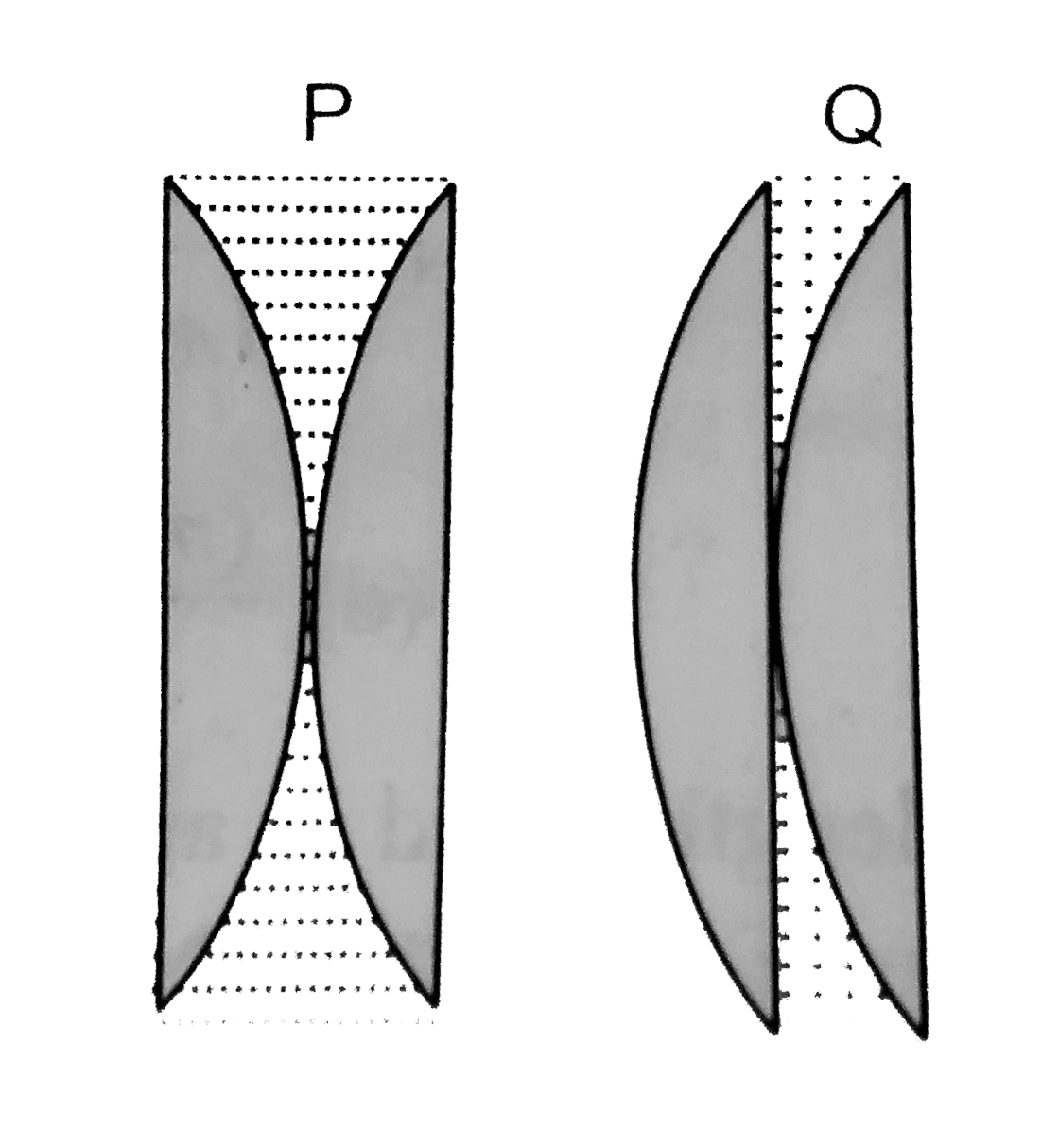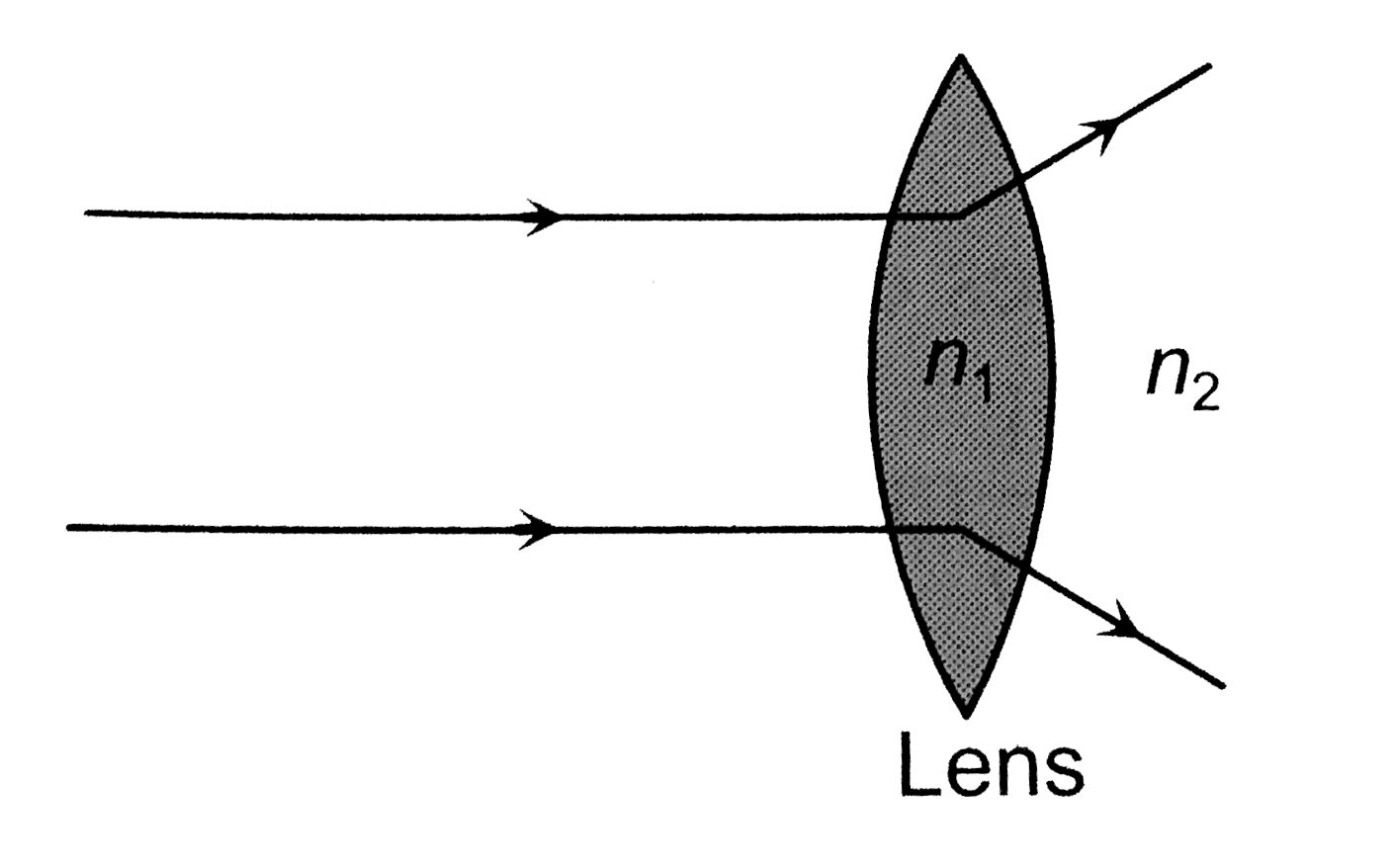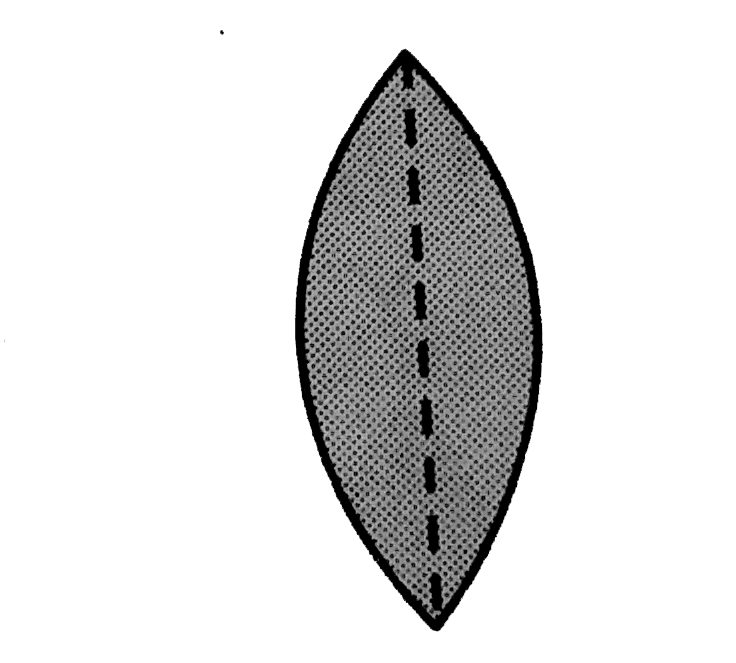Complete Solutions to Refraction At Curved Surface of chapter GEOMETRICAL OPTICS of Class 12 book with complete answers and questions
| Class 12 | PHYSICS |
| Chapter | GEOMETRICAL OPTICS |
| A2Z | Refraction At Curved Surface |
| Number Of Questions | 64 |
| Academic Year | 2023-24 |
A point object `O` is placed in front of a glass rod having spherical end of radius of curvature `30cm`. The image would be formed at
 03:39View Solution
03:39View SolutionRefraction takes place at a concave spherical boundary separating glass air medium. For the image to be real, the object distance `(mu_(g)=3//2)`
03:36View SolutionA plastic hemisphere has a radius of curvature of `8 cm` and an index of refraction of `1.6` . On the axis halfway between the plane surface and the spherical one `( 4 cm `from each`)` is a small object `O`.
The distance between the two images when viewed along the axis from the two sides of the hemisphere is approximately
 05:37View Solution
05:37View SolutionA point object is placed at the centre of a glass sphere of radius 6cm and refractive index 1.5. The distance of virtual image from the surface is
01:38View SolutionA spherical surface of radius of curvature R separates air (refractive index 1.0) from glass (refractive index 1.5). The centre of curvature is in the glass. A point object P placed in air is found to have a real image Q in the glass. The line PQ cuts the surface at a point O, and `PO=OQ`. The distance `PO`
03:26View SolutionA ray of light falls on a transparent sphere with center at C as shown in Figure . The ray emerges from the sphere parallel to line AB. Find the refractive index of the sphere.
 01:09View Solution
01:09View SolutionA ray of light in incident on a glass sphere of refractive index `3//2`. What should be the angle of incidence so that the ray which enters the sphere does not come out of the sphere ?
02:49View SolutionA convex lens of focal length `f` is placed somewhere in between an object and a screen. The distance between the object and the screen is `x`. If the numerical value of the magnification produced by the lens is `m`, then the focal lnegth oof the lens is .
05:14View SolutionA thin lens focal length `f_(1)` and its aperture has diameter `d`. It forms an image of intensity `I`. Now the central part of the aperture up to diameter`(d)/(2)` is blocked by an opaque paper. The focal length and image intensity will change to
03:50View SolutionA lens of power `+2` dioptres is placed in contact with a lens of power `-1` dioptre. The combination will behave like
02:35View SolutionA convex lens of focal length 40 cm is in contact with a concave lens of focal length 25 cm. The power of the combination is
01:41View SolutionTwo lenses are placed in contact with each other and the focal length of combination is `80 cm`. If the focal length of one is `20 cm`, then the power of the other will be
03:24View SolutionTwo similar planoconvex lenses are combined together in three different ways as shown in the adjoining figure. The ratio of the focal lengths in three cases will be
 01:58View Solution
01:58View SolutionTwo convex lenses of powers `4D` and `6D` are separated by a distance of `(1)/(6)m` . The power of the optical system so formed is
 02:44View Solution
02:44View SolutionThe slit of a collimator is illuminated by a source as shown in the adjoining figures. The distance between the slit `S` and the collimating lengs `L` is equal to the focal length of the lens. The correct direction of the emergent beam will be as shown in figure.
 02:14View Solution
02:14View SolutionA converging lens is used to form an image on a screen. When the upper half of the lens is covered by an opaque screen
02:23View SolutionThe ray diagram could be correct
 02:47View Solution
02:47View SolutionThe relation between `n_(1)` and `n_(2)` , if behavior of light rays is as shown in figure is
 02:15View Solution
02:15View SolutionThe minimum distance between an object and its real image formed by a convex lens is
03:55View SolutionAn object is placed at a distance of `f//2` from a convex lens. The image will be
03:11View SolutionA biconvex lens forms a real image of an object placed perpendicular to its principal axis. Suppose the radii of curvature of the lens tend to infinity. Then the image would
03:11View SolutionA lens is placed between a source of light and a wall. It forms images of area` A_(1)` and `A_(2)` on the wall for its two different positions. The area of the source of light is
05:27View SolutionA combination of two thin lenses with focal lengths `f_(1)` and `f_(2)` respectively forms and image of distant object at distance `60cm` when lenses are in contact. The position of this image shifts by `30 cm` towards the combination when two lenses are separated by `10 cm`. The corresponding values of `f_(1)` and `f_(2)` are
05:08View SolutionIf the central portion of a convex lens is wrapped in black paper as shown in figure
 03:15View Solution
03:15View SolutionA diminished image of an object is to be obtained on a screen 1.0 m from it. This can be achieved by appropriately placing
03:42View SolutionIn figure, an air lens of radius of curvature of each surface equal to `10 cm` is cut into a cylinder of glass of refractive index `1.5.` The focal length and the nature of lens are
 01:01View Solution
01:01View SolutionA lens ( focal length `50 cm` ) forms the image of a distant object which subtends an angle of 2 milliradian at the lens. What is the size of the image ?
03:26View SolutionA convex lens of focal length `12 cm` is made of glass of `mu=(3)/(2)`. What will be its focal length when immersed in liquid of `mu=(5)/(4)` ?
03:26View SolutionA concave lens of glass, refractive index 1.5 has both surfaces of same radius of curvature R. On immersion in a medium of refractive index 1.75, it will behave as a
04:15View SolutionA convex lens if in contact with concave lens. The magnitude of the ratio of their focal length is `(2)/(3)`. Their equivalent focal length is 30 cm. What are their individual focal lengths?
02:36View SolutionAn equiconvex lens of glass of focal length `0.1 ` meter is cut along a plane perpendicular to principle axis into two equal parts. The ratio of focal length of new lenses forms is
02:54View SolutionA thin lens made of a material of refractive index `mu_(0)` has a focal length `f_(0)` in air. Find the focal length of this lens if it is immersed in a liquid of refractive index `mu`.
01:47View SolutionA thin made of glass of refractive index `1.5` has a front surface `+11 D` power and back surface `-6D` . If this lens is submerged in a liquid of refractive index `1.6`, the resulting power of the lens is
04:13View SolutionLet `f_(v)` and `f_(r)` are the focal lengths of a convex lens for violet and red lights respectively. If `F_(v)` and `F_(r)` are the focal lengths of a concave lens for violet and red light respectively, then
03:54View SolutionA convex lens has a focal length `f`. It is cut into two parts along the dotted line as shown in figure. The focal length of each part will be
 02:35View Solution
02:35View SolutionA concave lens forms the image of an object such that the distance between the object and image is `10 cm` and the magnification produced is `1//4`. The focal length of the lens will be
04:59View SolutionAn object has image thrice of its original size when kept at `8 cm` and `16 cm` from a convex lens. Focal length of the lens is
04:08View SolutionA convex lens produces a real image `m` times the size of the object. What will be the distance of the object from the lens ?
02:06View SolutionA convex lens is made up of three different materials as shown in the figure. For a point object placed on its axis, the number of images formed are
 03:36View Solution
03:36View SolutionAn object is placed `12 cm` to the left of a converging lens of focal length `8cm`. Another converging lens of `6 cm` focal length is placed at a distance of `30 cm` to the right of the first lens. The second lens will produce
04:20View SolutionAn equiconvex lens is cut into two halves along `(i) XOX^(')` and `(ii) YOY^(')` as shown in the figure. Let `f,f^(')f^('')` be the focal lengths of the complete lens, of each half in case `(i)`, and of each half in case `(ii)`, respectively
Choose the correct statement from the following
 04:25View Solution
04:25View SolutionA magnifying glass is to be used at the fixed object distance of 1 inch. If it is to produce an erect image magnified 5 times its focal length should be
02:19View SolutionAn object is kept at a distance of `16 cm` from a thin lens and the image formed is real. If the object is kept at a distance of `6 cm` from the lens, the image formed is virtual. If the sizes of the images formed are equal, the focal length of the lens will be
03:10View SolutionAn object placed `10 cm` in front of a lens has an image `20 cm` behind the lens. What is the power of the lens`(` in diopters `)` ?
02:42View SolutionTwo lenses of power `+12` and `-2` diopters are placed in contact. The combined focal length of the combination will be
02:19View SolutionA convex lens of focal length 40 cm is in contact with a concave lens of focal length 25 cm. The power of the combination is
01:41View SolutionA convex lens of focal length 40 cm is in contact with a concave lens of focal length 25 cm. The power of the combination is
01:41View SolutionIf the space between the lenses in the lens combination shown were filled with water, what should happen to the focal length and power of the lens combination ?
 03:13View Solution
03:13View SolutionA convex lens is placed in contact with a mirror as shown. If he space between them is filed with water, its power will
 02:14View Solution
02:14View SolutionA convex lens if in contact with concave lens. The magnitude of the ratio of their focal length is `(2)/(3)`. Their equivalent focal length is 30 cm. What are their individual focal lengths?
02:36View SolutionA thin glass (refractive index 1.5) lens has optical power of `-5D` in air. Its optical power in a liquid medium with refractive index 1.6 will be
03:20View SolutionThe plane faces of two identical planoconvex lenses each having focal length of `40 cm` are pressed against each other to form a usual convex lens. The distance from this lens, at which an object must be placed to obtain a real, inverted image with magnification one is
03:28View SolutionIf two lenses of `+5` dioptres are mounted at some distance apart, the equivalent power will always be negative if the distance is
02:59View SolutionConsider an equiconvex lens of radius of curvature R and focal length f. If `fgtR` , the refractive index `mu` of the material of the lens
02:13View SolutionA car is fitted with a convex side-view mirror of focal length 20 cm. A second car 2.8m behind the first car is overtaking the first car at a relative speed of 15 `m/s`. The speed of the image of the second car as seen in the mrror of the first one is:
02:10View SolutionA car is fitted with a convex side-view mirror of focal length 20 cm. A second car 2.8m behind the first car is overtaking the first car at a relative speed of 15 `m/s`. The speed of the image of the second car as seen in the mrror of the first one is:
02:10View SolutionA car is fitted with a convex side-view mirror of focal length 20 cm. A second car 2.8m behind the first car is overtaking the first car at a relative speed of 15 `m/s`. The speed of the image of the second car as seen in the mrror of the first one is:
02:10View SolutionA convex lens of focal length `f` produces a virtual image `n` times the size of the object. Then the distance of the object from the lens is
03:00View SolutionAn object is placed `30 cm ` to the left of a diverging lens whose focal length is of magnitude `20 cm`. Which one of the following correctly states the nature and position of the virtual image formed ?
03:43View SolutionA lens forms a real image of an object. The distance from the object to the lens is x cm and that from the lens to the image is y cm. The graph shows the variation of y with x.
It can be deduced that the lens is
 02:40View Solution
02:40View SolutionTwo identical glass `(mu_(g)=3//2)` equiconvex lenses of focal length `f` are kept in contact. The space between the two lenses is filled with water `(mu_(w)=4//3)`. The focal length of the combination is
06:36View SolutionWhich one of the following spherical lenses does not exhibit dispersion? The radii of curvature of the surfaces of the lenses are as given in the diagrams. `
01:28View SolutionA student measures the focal length of a convex lens by putting an object pin at a distance `u` from the lens and measuring the distance `v` of the image pin. The graph between `u` and `v` plotted by the student should look like
02:04View SolutionFor a convex lens, if real image is formed the graph between `(u+v)` and `u` or `v` is as follows
03:55View Solution
Refraction At Curved Surface questions and complete solutions for chapter GEOMETRICAL OPTICS of A2Z PHYSICS (HINGLISH) of Class 12
